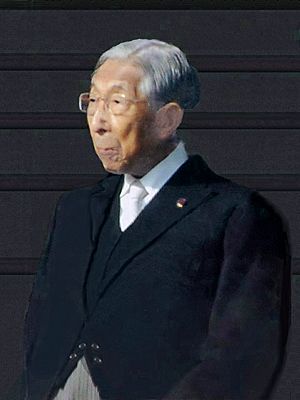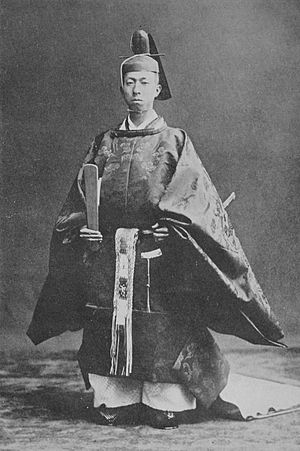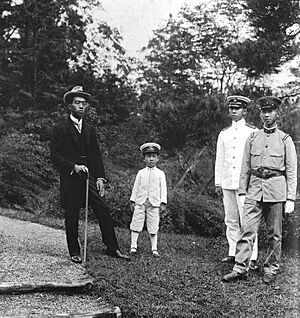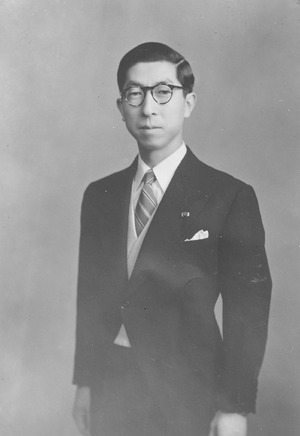Takahito, Prince Mikasa facts for kids
Quick facts for kids Takahito |
|||||
|---|---|---|---|---|---|
| Prince Mikasa | |||||

Prince Mikasa in 2012
|
|||||
| Born | 2 December 1915 Tokyo Imperial Palace, Tokyo City, Empire of Japan (now Chiyoda, Tokyo) |
||||
| Died | 27 October 2016 (aged 100) St. Luke's International Hospital, Chūō, Tokyo, Japan |
||||
| Burial | 4 November 2016 Toshimagaoka Imperial Cemetery, Tokyo |
||||
| Spouse | |||||
| Issue |
|
||||
|
|||||
| House | Imperial House of Japan | ||||
| Father | Emperor Taishō | ||||
| Mother | Sadako Kujō | ||||
| Military career | |||||
| Allegiance | |||||
| Service/ |
|||||
| Years of service | 1932–1945 | ||||
| Rank | |||||
| Unit |
|
||||
| Battles/wars | |||||
Takahito, Prince Mikasa (三笠宮崇仁親王 (Mikasa-no-miya Takahito Shinnō)) was a Japanese prince. He was born on December 2, 1915, and passed away on October 27, 2016. He was the youngest of the four sons of Emperor Taishō and Empress Teimei. His oldest brother was Emperor Shōwa.
Prince Mikasa served in the Japanese Imperial Army during World War II. After the war, he became a scholar. He taught about Middle Eastern studies and Semitic languages, and was very interested in Jewish studies.
In 1941, Prince Mikasa married Yuriko Takagi. They had three sons and two daughters. Prince and Princess Mikasa lived longer than all three of their sons. After his sister-in-law Kikuko, Princess Takamatsu died in 2004, Prince Mikasa became the oldest living member of the Imperial House of Japan. He was active until a few months before his death at the age of 100. When he died, Prince Mikasa was the oldest living royal in the world.
Contents
Prince Takahito's Early Life
Prince Takahito was born at the Tokyo Imperial Palace on December 2, 1915. His parents were Emperor Taishō and Empress Teimei. He was 14 years younger than his oldest brother, Crown Prince Hirohito, who later became Emperor Shōwa. As a child, he was called Sumi-no-miya.
From 1922 to 1932, Prince Takahito went to the Gakushūin (Peers' School). By the time he started secondary school, his oldest brother was already the Emperor. His other two brothers, Prince Chichibu and Prince Takamatsu, had joined the Japanese Imperial Army and Japanese Imperial Navy. In 1932, Takahito joined the Imperial Japanese Army Academy. He became a sub-lieutenant in June 1936 and was assigned to the Fifth Cavalry Regiment. He also graduated from the Army Staff College.
In December 1935, when he became an adult, Emperor Shōwa gave him the title Mikasa-no-miya (Prince Mikasa). This allowed him to start a new branch of the Imperial Family.
Prince Mikasa's Military Service
Prince Mikasa was promoted to lieutenant in 1937 and to captain in 1939. He served in China using the name "Wakasugi". During his time in the army, he often spoke out against the Japanese military's actions in China.
In an interview in 1994, he said he was "strongly shocked" by some of the things the Imperial Army did. He criticized the army's invasion and harsh treatment of people in China. He even showed his brother, Emperor Hirohito, a film about these events.
Prince Mikasa wrote in his memoirs that he visited a military headquarters in China. There, he saw films that showed experiments on people. In 1994, a newspaper shared a strong report he had written about the Japanese Imperial Army's actions. The army had tried to hide this report, but one copy survived. After the war, it was said that Prince Mikasa was very strict about discipline and against cruel actions by soldiers in China.
He was promoted to major in 1941. From January 1943 to January 1944, Prince Mikasa worked as a staff officer in the Headquarters of the China Expeditionary Army in Nanjing, China. He tried to help bring peace, but his efforts were stopped by a large military operation.
Prince Mikasa continued to serve as a staff officer in Tokyo until Japan surrendered in August 1945. After the war ended, he suggested that Emperor Hirohito should step down to take responsibility for the war.
Prince Mikasa's Marriage and Family
On October 22, 1941, Prince Mikasa married Yuriko Takagi. She was the second daughter of Viscount Masanari Takagi. Prince and Princess Mikasa had five children. Their two daughters left the Imperial Family when they got married. All of their sons passed away before them. Besides their five children, they had nine grandchildren and seven great-grandchildren by 2022.
Prince Mikasa's Children
- Yasuko Konoe (近衛やす子, Konoe Yasuko) (formerly Princess Yasuko of Mikasa, born April 26, 1944); she married Tadateru Konoe in 1966. They have one son, Tadahiro.
- Prince Tomohito of Mikasa (寬仁親王, Tomohito Shinnō) (January 5, 1946 – June 6, 2012); he was the heir. He married Nobuko Asō in 1980. They had two daughters.
- Yoshihito, Prince Katsura (桂宮宜仁親王, Katsura-no-miya Yoshihito Shinnō) (February 11, 1948 – June 8, 2014); he was given the title Katsura-no-miya in 1988.
- Masako Sen (千容子, Sen Masako) (formerly Princess Masako of Mikasa, born October 23, 1951); she married Sōshitsu Sen in 1983. He is the head of the Urasenke Japanese tea ceremony School. They have two sons and one daughter.
- Norihito, Prince Takamado (高円宮憲仁親王, Takamado-no-miya Norihito Shinnō) (December 29, 1954 – November 21, 2002); he was given the title Takamado-no-miya in 1984. He married Hisako Tottori in 1984. They had three daughters.
Prince Mikasa's Life After the War
After Japan lost World War II, some members of the imperial family thought Emperor Hirohito should give up his throne. On February 27, 1946, Prince Mikasa even spoke to the Privy Council. He suggested the Emperor should step down and take responsibility for Japan's defeat. However, General Douglas MacArthur, the top American military commander in Japan, wanted Emperor Hirohito to remain on the throne.
After the war, Prince Mikasa went to the University of Tokyo. He studied archaeology, Middle Eastern studies, and Semitic languages. From 1954 until his death, he led the Japanese Society for Middle East Studies. He was also the honorary president of the Japan Society of Orientology.
Prince Mikasa taught about Middle Eastern studies and archaeology at many universities. These included Tokyo National University of Fine Arts and Music and the University of London. He often appeared on radio and television to talk about cultural topics. People knew him as "the Imperial scholar." He was especially interested in Jewish studies. He believed that understanding Judaism helped him feel proud to be Japanese.
Prince Mikasa's Final Years and Death
As he got older, Prince Mikasa made fewer public appearances. He often used a wheelchair. He and Princess Mikasa lived at the Akasaka Estate in Tokyo. In 2012, he had heart surgery and recovered well. He exercised daily with his wife and enjoyed going outside in his wheelchair. He also liked getting haircuts and attending family events. In October 2014, he went to his granddaughter Princess Noriko's wedding in Tokyo. Staff said he seemed strong until his last days and always helped his wife. He enjoyed reading newspapers and watching sumo and music on TV.
On December 2, 2015, Prince Mikasa became the first member of the imperial family to reach 100 years old. On his birthday, he said he wanted to live pleasantly and peacefully. He prayed for world happiness and thanked his wife, Yuriko, for supporting him for over 70 years. In April 2016, he met the Japanese ambassador to Turkey and took a walk at the Akasaka Detached Palace.
On May 16, 2016, Prince Mikasa was taken to St. Luke's International Hospital in Tokyo. He had pneumonia. He stayed in the hospital for the rest of his life. His heart weakened in June, and fluid built up in his lungs. Princess Yuriko and other Imperial family members, including the Emperor and Empress, visited him often. In his last days, Prince Mikasa was still able to respond to visitors. On October 22, he and his wife celebrated their 75th wedding anniversary in his hospital room. His condition improved enough for him to start rehabilitation exercises in bed. However, on October 27, his heart slowed down and stopped. Prince Mikasa was pronounced dead at 8:34 a.m., with his wife by his side. When he died, he had outlived all of his brothers and sisters, and all three of his sons. He was also the last living grandson of Emperor Meiji.
Prince Mikasa's funeral was held on November 4, 2016, at Toshimagaoka Imperial Cemetery. About 580 people attended, including members of the Imperial Family, Prime Minister Shinzō Abe, and former imperial family members. Princess Mikasa led the ceremony as the chief mourner.
Honors and Awards
Prince Mikasa received many honors during his life.
National Honors
- Knight Grand Cordon of the Order of the Chrysanthemum (Japan's highest order)
International Honors
 Brazil: Grand Cross of the Order of the Southern Cross
Brazil: Grand Cross of the Order of the Southern Cross Bulgaria: Commander of the Order of the Balkan Mountains
Bulgaria: Commander of the Order of the Balkan Mountains Denmark: Knight of the Order of the Elephant
Denmark: Knight of the Order of the Elephant Empire of Iran: Member 2nd Class of the Imperial Order of Pahlavi
Empire of Iran: Member 2nd Class of the Imperial Order of Pahlavi Empire of Iran: Recipient of the Commemorative Medal of the 2,500 year Celebration of the Persian Empire
Empire of Iran: Recipient of the Commemorative Medal of the 2,500 year Celebration of the Persian Empire Italy: Knight Grand Cross of the Order of Merit of the Italian Republic
Italy: Knight Grand Cross of the Order of Merit of the Italian Republic Netherlands: Knight Grand Cross of the Order of the Crown
Netherlands: Knight Grand Cross of the Order of the Crown Norway: Grand Cross of the Order of St. Olav
Norway: Grand Cross of the Order of St. Olav Peru: Grand Cross of the Order of the Sun
Peru: Grand Cross of the Order of the Sun Sweden: Knight of the Royal Order of the Seraphim
Sweden: Knight of the Royal Order of the Seraphim Turkey: recipient of the Atatürk International Peace Prize
Turkey: recipient of the Atatürk International Peace Prize
Honorary Positions
- Honorary President of the Middle Eastern Culture Center in Japan
- Honorary President of the Japan – Turkey Society
- Honorary Vice-President of the Japanese Red Cross Society
See also
 In Spanish: Takahito de Mikasa para niños
In Spanish: Takahito de Mikasa para niños





